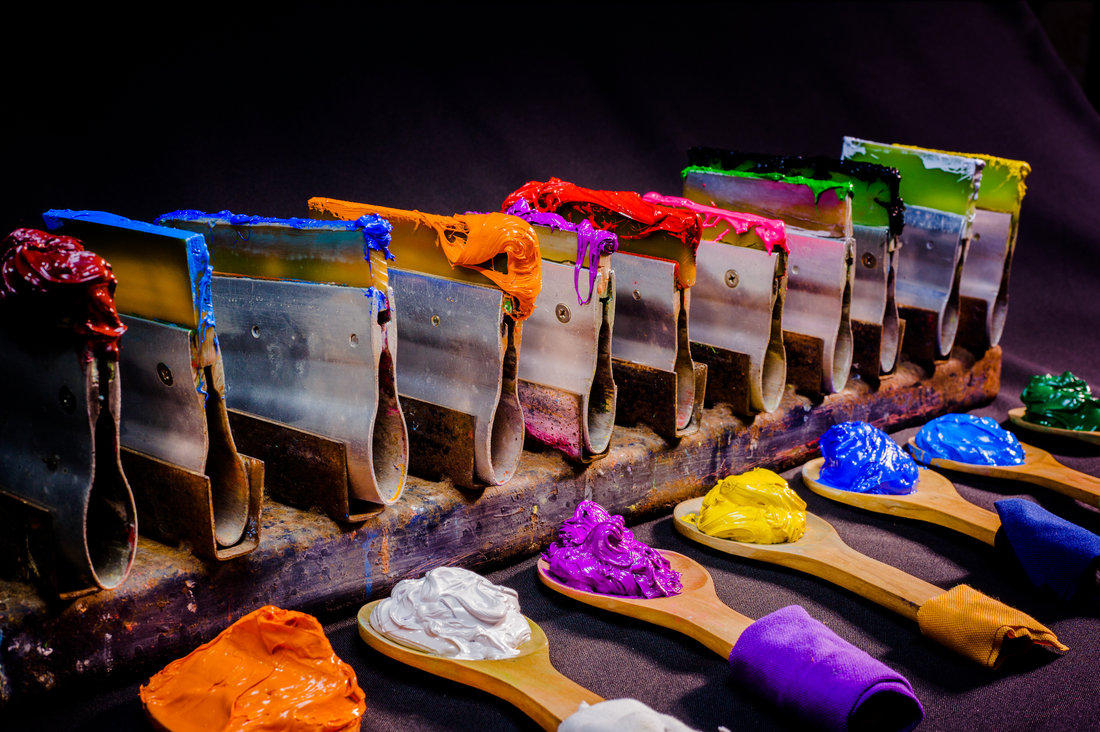Introduction
Screen printing is a versatile and widely-used method for creating custom designs on textiles, paper, and other surfaces. To produce high-quality prints, you'll need the right supplies and equipment. In this article, we'll cover the essential screen printing supplies you need to get started on your journey.
Screen Printing Frames
Screen printing frames are used to hold the mesh screen in place while printing. They can be made of wood or aluminum, with aluminum being the more durable option. Choose frames that are the right size for your designs and ensure they are sturdy and easy to handle.

Example of screen print frames
Screen Printing Mesh
Example of screen print mesh
Thread Count
Low Thread Count
A low thread count mesh is perfect for printing larger designs and thicker inks. The larger openings in the mesh allow for more ink to pass through, creating bold prints.
High Thread Count
A high thread count mesh is suitable for printing intricate designs with fine lines and details. The smaller openings in the mesh allow for precise ink control, producing crisp prints.
Material
Polyester Mesh
Polyester mesh is the most common type of mesh used in screen printing. It is affordable, durable, and provides excellent tension, making it ideal for most projects.
Stainless Steel Mesh
Stainless steel mesh is used for specialized applications that require extreme precision and durability. It is more expensive than polyester mesh, but it can withstand higher tension and last longer.
Screen Printing Inks
Example of plastisol ink for screen printing
Water-Based Inks
Water-based inks are eco-friendly and provide a soft hand feel on the printed surface. They are easy to clean up and work well with various materials, but they can dry quickly on screens, making them more challenging to work with for beginners.
Plastisol Inks
Plastisol inks are the most popular choice for screen printing, as they are versatile, durable, and easy to work with. They do not dry on the screen and produce vibrant colors. However, plastisol inks require heat to cure, and they tend to create a thicker print on the material.
Discharge Inks
Discharge inks are used to create a softer print on dark garments by removing the dye from the fabric and replacing it with the ink color. Discharge inks require an activator to work, and they can be a bit more challenging to use than other inks.
Squeegees
Squeegees are essential tools for pushing ink through the mesh screen onto the substrate. They come in various sizes, shapes, and materials, with rubber or polyurethane blades. Choose a squeegee with the right blade durometer (hardness) to suit the ink type and design you're working with.

Example of a squeegee for screen printing
Emulsion and Exposure Unit
Emulsion
Emulsion is a photosensitive liquid that is applied to the mesh screen to create the stencil for your design. There are different types of emulsion available, such as diazo, photopolymer, and dual-cure, each with unique characteristics. Select the right emulsion based on your chosen ink type and exposure unit.
Exposure Unit
An exposure unit is used to cure the emulsion on the screen, creating a stencil of your design. There are various exposure units available, ranging from simple DIY setups to professional-grade equipment. Choose an exposure unit that suits your needs and budget.
Screen Printing Press
A screen printing press holds the frame and substrate in place while you print. There are manual and automatic presses available, with manual presses being more affordable and suitable for beginners. Choose a press with the appropriate number of stations and colors for your projects.

Example of a screen printing press
Conveyor Dryer and Flash Dryer
Conveyor Dryer
A conveyor dryer is used to cure plastisol inks on garments. The dryer ensures even heat distribution and optimal curing time. Conveyor dryers can be a significant investment, but they are essential for high-volume production.
Flash Dryer
A flash dryer is an affordable alternative to a conveyor dryer for small-scale operations. It is used to partially cure inks between color layers or fully cure the final print. Flash dryers are portable and easy to set up, making them a popular choice for beginner screen printers.
Cleaning Supplies
Proper cleaning and maintenance of your screen printing equipment are crucial for producing high-quality prints. Invest in screen printing-specific cleaning supplies, such as ink removers, emulsion removers, and degreasers, to keep your screens and tools in optimal condition.
Conclusion
Screen printing is a rewarding and creative process that requires the right supplies and equipment. By investing in high-quality frames, mesh, inks, squeegees, emulsion, exposure units, presses, and dryers, you'll be well on your way to producing professional-grade prints.
FAQs
Q1: Can I use regular household cleaning supplies for screen printing cleanup?
A1: It's best to use screen printing-specific cleaning supplies to ensure proper care for your equipment and screens. Household cleaners may not be as effective and could damage your screens.
Q2: Can I use the same mesh screen for all my screen printing projects?
A2: It depends on the design and ink type. Using the appropriate mesh count and material for each project will yield the best results. Experiment with different mesh counts and materials to find the perfect combination for your specific needs.
Q3: How do I choose the right squeegee for my project?
A3: Choose a squeegee based on the ink type, design, and substrate. Consider the blade durometer (hardness) to ensure proper ink transfer. A softer blade is suitable for uneven surfaces and thicker inks, while a harder blade works best for smooth surfaces and thinner inks.
Q4: What type of screen printing press is best for beginners?
A4: A manual screen printing press is an excellent choice for beginners, as it is more affordable and easier to learn compared to an automatic press. Look for a press with the appropriate number of stations and colors to suit your projects.
Q5: How can I ensure my prints last longer?
A5: Properly curing your prints, using high-quality inks, and following the manufacturer's recommendations for care will help ensure your prints last longer. Additionally, consider using a heat press to set the ink after printing for added durability.
Equipment
Unveiling the Best Screen Printing Machines for Beginners: Your Ultimate Guide
How to Choose the Right Screen Printing Press for Your Business: A Comprehensive Guide
The Ultimate Screen Printing Kit Buying Guide
Ink
A Beginner's Guide to Screen Printing Inks
Why Water-Based Screen Printing Ink is the Future
The Benefits of Using Discharge Screen Printing Ink
Screen
How to Choose the Right Screen Printing Mesh for Your Project
Everything You Need to Know About Screen Printing Frames
The Ultimate Guide to Screen Printing Emulsion
Technique
7 Essential Screen Printing Techniques for Beginners
How to Screen Print on Fabric: A Beginner's Guide
The Basics of Screen Printing on Paper
Service
Get Custom Screen Printing for Your Business or Event
Find Screen Printing Services Near You
The Best Online Screen Printing Services for Your Business
Supplies
The Essential Screen Printing Supplies You Need



